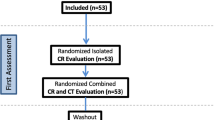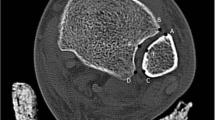Abstract
Introduction
It remains unclear whether computed tomography (CT) is superior to plain radiography in detecting lateral hinge fractures after medial opening-wedge supramalleolar osteotomy (SMO) of the ankle joint. This study aimed to evaluate the disparity between postoperative plain radiography and CT in detecting lateral hinge fractures after medial opening-wedge SMO and to identify the predictive factors of lateral hinge fractures.
Materials and methods
This retrospective study included 39 patients who underwent medial opening-wedge SMO. The immediate postoperative plain radiography and CT scan images were retrieved, and the presence of lateral hinge fractures was independently determined. Depending on the fracture gap, the lateral hinge fractures were subclassified as stable (gap < 2 mm) or unstable (gap ≥ 2 mm) fractures. To investigate the predictive factors, the cases were divided based on diagnostic tools such as plain radiography and CT.
Results
The incidence of lateral hinge fractures was 48.7% (19/39) on plain radiographs and 61.5% (24/39) on CT scans. Five cases of lateral hinge fractures additionally detected on CT scans were stable fractures, and all had been classified as no fracture on plain radiographs. The unstable fractures that had been subclassified based on plain radiographs did not change on CT scans. None of the variables were associated with the presence of lateral hinge fractures on plain radiographs and CT scans.
Conclusions
Postoperative CT after medial opening-wedge SMO has no additional diagnostic value if the lateral hinge fracture has already been diagnosed on plain radiography. Therefore, postoperative CT is only recommended when lateral hinge fractures are not visible on plain radiographs.


Similar content being viewed by others
References
Barg A, Pagenstert GI, Horisberger M, Paul J, Gloyer M, Henninger HB, Valderrabano V (2013) Supramalleolar osteotomies for degenerative joint disease of the ankle joint: indication, technique and results. Int Orthop 37:1683–1695. https://doi.org/10.1007/s00264-013-2030-2
Lacorda JB, Jung HG, Im JM (2020) Supramalleolar distal tibiofibular osteotomy for medial ankle osteoarthritis: current concepts. Clin Orthop Surg 12:271–278. https://doi.org/10.4055/cios20038
Nha KW, Lee SH, Rhyu IJ, Kim HJ, Song JG, Han JH, Yeo ED, Lee YK (2016) Safe zone for medial open-wedge supramalleolar osteotomy of the ankle: a cadaveric study. Foot Ankle Int 37:102–108. https://doi.org/10.1177/1071100715597438
Kang KT, Koh YG, Lee JA, Lee JJ, Kwon SK (2020) Biomechanical effect of a lateral hinge fracture for a medial opening wedge high tibial osteotomy: finite element study. J Orthop Surg Res 15:63. https://doi.org/10.1186/s13018-020-01597-7
Miller BS, Dorsey WO, Bryant CR, Austin JC (2005) The effect of lateral cortex disruption and repair on the stability of the medial opening wedge high tibial osteotomy. Am J Sports Med 33:1552–1557. https://doi.org/10.1177/0363546505275488
Miller BS, Downie B, McDonough EB, Wojtys EM (2009) Complications after medial opening wedge high tibial osteotomy. Arthroscopy 25:639–646. https://doi.org/10.1016/j.arthro.2008.12.020
Barg A, Saltzman CL (2014) Single-stage supramalleolar osteotomy for coronal plane deformity. Curr Rev Musculoskelet Med 7:277–291. https://doi.org/10.1007/s12178-014-9231-1
Borrelli J Jr, Goldfarb C, Catalano L, Evanoff BA (2002) Assessment of articular fragment displacement in acetabular fractures: a comparison of computerized tomography and plain radiographs. J Orthop Trauma 16:449–456. https://doi.org/10.1097/00005131-200208000-00001 (discussion 456–447)
Mustonen AO, Koskinen SK, Kiuru MJ (2005) Acute knee trauma: analysis of multidetector computed tomography findings and comparison with conventional radiography. Acta Radiol 46:866–874. https://doi.org/10.1080/02841850500335135
Neubauer J, Benndorf M, Ehritt-Braun C, Reising K, Yilmaz T, Klein C, Zajonc H, Kotter E, Langer M, Goerke SM (2018) Comparison of the diagnostic accuracy of cone beam computed tomography and radiography for scaphoid fractures. Sci Rep 8:3906. https://doi.org/10.1038/s41598-018-22331-8
Omid R, Kidd C, Yi A, Villacis D, White E (2016) Measurement of clavicle fracture shortening using computed tomography and chest radiography. Clin Orthop Surg 8:367–372. https://doi.org/10.4055/cios.2016.8.4.367
Lee OS, Lee YS (2018) Diagnostic value of computed tomography and risk factors for lateral hinge fracture in the open wedge high tibial osteotomy. Arthroscopy 34:1032–1043. https://doi.org/10.1016/j.arthro.2017.08.310
Lee SS, Celik H, Lee DH (2018) Predictive factors for and detection of lateral hinge fractures following open wedge high tibial osteotomy: plain radiography versus computed tomography. Arthroscopy 34:3073–3079. https://doi.org/10.1016/j.arthro.2018.06.041
Lee WC, Moon JS, Lee K, Byun WJ, Lee SH (2011) Indications for supramalleolar osteotomy in patients with ankle osteoarthritis and varus deformity. J Bone Jt Surg Am 93:1243–1248. https://doi.org/10.2106/JBJS.J.00249
Tanaka Y, Takakura Y, Hayashi K, Taniguchi A, Kumai T, Sugimoto K (2006) Low tibial osteotomy for varus-type osteoarthritis of the ankle. J Bone Jt Surg Br 88:909–913. https://doi.org/10.1302/0301-620X.88B7.17325
Ettinger S, Schwarze M, Yao D, Ettinger M, Claassen L, Stukenborg-Colsman C, Thermann H, Plaass C (2018) Stability of supramalleolar osteotomies using different implants in a sawbone model. Arch Orthop Trauma Surg 138:1359–1363. https://doi.org/10.1007/s00402-018-2981-2
Pagenstert GI, Hintermann B, Barg A, Leumann A, Valderrabano V (2007) Realignment surgery as alternative treatment of varus and valgus ankle osteoarthritis. Clin Orthop Relat Res 462:156–168. https://doi.org/10.1097/BLO.0b013e318124a462
Faict S, Burssens A, Van Oevelen A, Maeckelbergh L, Mertens P, Buedts K (2021) Correction of ankle varus deformity using patient-specific dome-shaped osteotomy guides designed on weight-bearing CT: a pilot study. Arch Orthop Trauma Surg. https://doi.org/10.1007/s00402-021-04164-9
Landis JR, Koch GG (1977) The measurement of observer agreement for categorical data. Biometrics 33:159–174
Kim YS, Kim YB, Koh YG (2019) Prognostic factors affecting correction angle changes after supramalleolar osteotomy using an opening wedge plate for varus ankle osteoarthritis. J Foot Ankle Surg 58:417–422. https://doi.org/10.1053/j.jfas.2018.09.003
Myerson MS, Zide JR (2013) Management of varus ankle osteoarthritis with joint-preserving osteotomy. Foot Ankle Clin 18:471–480. https://doi.org/10.1016/j.fcl.2013.06.006
Knupp M, Bolliger L, Hintermann B (2012) Treatment of posttraumatic varus ankle deformity with supramalleolar osteotomy. Foot Ankle Clin 17:95–102. https://doi.org/10.1016/j.fcl.2011.11.007
Maeda K, Mochizuki T, Kobayashi K, Tanifuji O, Someya K, Hokari S, Katsumi R, Morise Y, Koga H, Sakamoto M, Koga Y, Kawashima H (2020) Cortical thickness of the tibial diaphysis reveals age- and sex-related characteristics between non-obese healthy young and elderly subjects depending on the tibial regions. J Exp Orthop 7:78. https://doi.org/10.1186/s40634-020-00297-9
Golano P, Vega J, de Leeuw PA, Malagelada F, Manzanares MC, Gotzens V, van Dijk CN (2016) Anatomy of the ankle ligaments: a pictorial essay. Knee Surg Sports Traumatol Arthrosc 24:944–956. https://doi.org/10.1007/s00167-016-4059-4
Funding
No benefits in any form have been received or will be received from a commercial party related directly or indirectly to the contents of this study.
Author information
Authors and Affiliations
Contributions
YHP: lead investigator and first author. HJL: data analysis and manuscript review. JWC: data analysis and manuscript review. HJK: corresponding author, primary surgeon.
Corresponding author
Ethics declarations
Conflict of interest
We have no conflict of interests to declare.
Ethical approval
This study was approved by the local Ethics Committee (IRB No. 2020GR0514).
Informed consent
Informed consent was waived because of the retrospective nature of the study and the analysis used anonymous clinical data.
Additional information
Publisher's Note
Springer Nature remains neutral with regard to jurisdictional claims in published maps and institutional affiliations.
Rights and permissions
About this article
Cite this article
Park, Y.H., Lee, H.J., Choi, J.W. et al. Value of postoperative computed tomography for the diagnosis of lateral hinge fracture in medial opening-wedge supramalleolar osteotomy. Arch Orthop Trauma Surg 143, 1379–1385 (2023). https://doi.org/10.1007/s00402-021-04301-4
Received:
Accepted:
Published:
Issue Date:
DOI: https://doi.org/10.1007/s00402-021-04301-4




